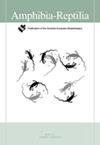中东河蝾螈生态位演化和多样化:对未来气候变化的脆弱性
IF 1.3
4区 生物学
Q3 ZOOLOGY
引用次数: 0
摘要
摘要副齿兽(paractylodon)孑孓属分布狭窄,主要分布在中东地区的温带森林中,包括阿富汗的P. mustersi,伊朗西北部和东北部的P. persicus和P. gorganensis。最近的系统发育分析表明,伊朗副齿龙种群可能属于一个单一物种,P. persicus。在这项研究中,我们利用生态位模型和多元生态位分析来确定生态位重叠并评估等效性和相似性测试,探讨了气候生态位保守性和/或生态位分化如何影响所有副栉齿兽物种的进化。我们还使用了十种算法的集合来预测最近(1970-2000)和未来(2081-2100)气候条件下的副齿龙物种分布。结果表明,未来气候变化可能导致这些物种80% ~ 97%的适宜栖息地丧失,特别是在低海拔地区。生态位等效性检验结果支持了生态位分化假说,结果表明,蜜桃与甘草木(P. pericus vs. gorganensis, P.反之)的重叠程度中等(D = 0.23, I = 0.41),蜜桃与鼠草木(P. musstersi, P.反之)的重叠程度较小(D = 0.05, I = 0.06)。同时,对生态位保守性假设进行生态位相似性检验,结果表明,蜜桃与枸杞、桃蚜与桃蚜、桃蚜+枸杞(作为一个单一物种)与桃蚜具有显著性差异。由于这些复杂的进化生态模式和异域分布,我们建议将古organensis视为一个有效的亚种。本文章由计算机程序翻译,如有差异,请以英文原文为准。
Niche evolution and diversification in Middle Eastern stream salamanders (Paradactylodon): vulnerability to future climate change
Abstract The relict genus Paradactylodon is narrowly distributed in temperate forests throughout the Middle East region, including P. mustersi in Afghanistan, P. persicus , and P. gorganensis in northwestern and northeastern Iran. Recent phylogenetic analyses suggest that the Iranian Paradactylodon populations may belong to a single species, P. persicus . In this study, we addressed how climatic niche conservatism and/or niche divergence may have affected the evolution of all Paradactylodon species using ecological niche models and multivariate niche analyses to identify niche overlap and assess equivalency and similarity tests. We also used an ensemble of ten algorithms to predict Paradactylodon species distributions for recent (1970-2000) and future (2081-2100) climate conditions. The results show that future climate change may cause the loss of 80 to 97% of these species’ suitable habitat, especially at lower elevations. The niche divergence hypothesis was supported by the results of niche equivalency tests on P. persicus vs. P. gorganensis (and vice versa) with moderate overlap (D = 0.23, I = 0.41) and P. persicus vs. P. mustersi (and vice versa) with little overlap (D = 0.05, I = 0.06). Meanwhile, the niche similarity test for the niche conservatism hypothesis revealed significant results for P. persicus vs. P. gorganensis , P. mustersi vs. P. persicus , and P. persicus + P. gorganensis (as a single species) vs. P. mustersi . Due to these complex evolutionary ecological patterns and allopatric distributions, we recommend that P. gorganensis be considered a valid subspecies.
求助全文
通过发布文献求助,成功后即可免费获取论文全文。
去求助
来源期刊

Amphibia-Reptilia
生物-动物学
CiteScore
3.10
自引率
6.20%
发文量
39
审稿时长
6-12 weeks
期刊介绍:
Amphibia-Reptilia is a leading European multi-disciplinary journal devoted to most of the aspects of herpetology: ecology, behaviour, evolution, conservation, physiology, morphology, paleontology, genetics, and systematics.
Amphibia-Reptilia publishes high quality original papers, short-notes, reviews, book reviews and news of the Societas Europaea Herpetologica (SEH). The Societas Europaea Herpteologica (SEH) website is located at: www.seh-herpetology.org.
 求助内容:
求助内容: 应助结果提醒方式:
应助结果提醒方式:


